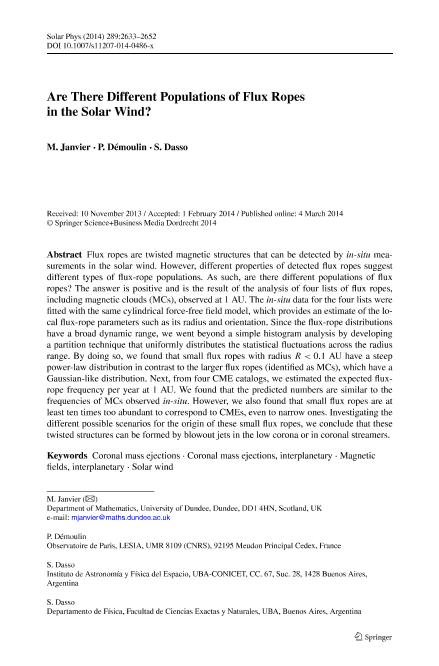Artículo
Are There Different Populations of Flux Ropes in the Solar Wind?
Fecha de publicación:
07/2014
Editorial:
Springer
Revista:
Solar Physics
ISSN:
0038-0938
e-ISSN:
1573-093X
Idioma:
Inglés
Tipo de recurso:
Artículo publicado
Clasificación temática:
Resumen
Flux ropes are twisted magnetic structures that can be detected by in-situ measurements in the solar wind. However, different properties of detected flux ropes suggest different types of flux-rope populations. As such, are there different populations of flux ropes? The answer is positive and is the result of the analysis of four lists of flux ropes, including magnetic clouds (MCs), observed at 1 AU. The in-situ data for the four lists were fitted with the same cylindrical force-free field model, which provides an estimate of the local flux-rope parameters such as its radius and orientation. Since the flux-rope distributions have a broad dynamic range, we went beyond a simple histogram analysis by developing a partition technique that uniformly distributes the statistical fluctuations across the radius range. By doing so, we found that small flux ropes with radius R<0.1 AU have a steep power-law distribution in contrast to the larger flux ropes (identified as MCs), which have a Gaussian-like distribution. Next, from four CME catalogs, we estimated the expected flux-rope frequency per year at 1 AU. We found that the predicted numbers are similar to the frequencies of MCs observed in-situ. However, we also found that small flux ropes are at least ten times too abundant to correspond to CMEs, even to narrow ones. Investigating the different possible scenarios for the origin of these small flux ropes, we conclude that these twisted structures can be formed by blowout jets in the low corona or in coronal streamers.
Archivos asociados
Licencia
Identificadores
Colecciones
Articulos(IAFE)
Articulos de INST.DE ASTRONOMIA Y FISICA DEL ESPACIO(I)
Articulos de INST.DE ASTRONOMIA Y FISICA DEL ESPACIO(I)
Citación
Janvier, M.; Démoulin, Pascal; Dasso, Sergio Ricardo; Are There Different Populations of Flux Ropes in the Solar Wind?; Springer; Solar Physics; 289; 7; 7-2014; 2633-2652
Compartir
Altmétricas




